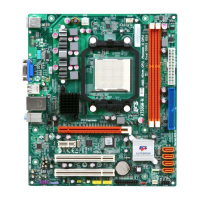
Do you have a question about the ECS A750GM-M and is the answer not in the manual?
| Form Factor | Micro ATX |
|---|---|
| Socket Type | AM5 |
| Chipset | AMD B650 |
| Memory Type | DDR5 |
| Memory Slots | 4 |
| Max Memory | 128GB |
| Video Outputs | 1 x HDMI, 1 x DisplayPort |
| Storage Interface | 4 x SATA 6Gb/s |
| Audio | Realtek ALC897 |
| LAN | Realtek RTL8111 |
Details about the motherboard's features, including processor, chipset, memory, and audio.
Lists the expansion slots and connectors available on the motherboard.
Describes the rear panel I/O ports and connectors.
Explains the functionality of the BIOS firmware for system configuration.
Identifies and describes the key physical components on the motherboard.
Essential safety guidelines to follow during motherboard installation.
Step-by-step instructions for mounting the motherboard inside a computer case.
Explains how to set jumpers for correct motherboard configuration.
Covers the installation of essential hardware components like CPU and memory.
Details the different expansion slots available and their uses.
Guide to connecting various optional devices and front panel headers.
Instructions for connecting power cables and case components to the motherboard.
Information on connecting front panel switches, LEDs, and audio.
Introduction to the BIOS Setup Utility and its configuration options.
Steps to access the BIOS Setup Utility after powering on the system.
Displays basic system information and allows configuration of date, time, and devices.
Advanced system settings including CPU, boot devices, and special functions.
Configuration options for onboard devices like IDE, SATA, Audio, and LAN.
Monitors critical voltages, temperatures, and fan speeds for system health.
Instructions for downloading and installing updated BIOS versions.
Overview of the software included on the motherboard's support disc.
Guide to the automatic installation process for drivers and utilities.
Step-by-step instructions for installing device drivers and software.
Procedures for installing drivers manually if the auto-install fails.
Information on the available utility software and licensing.
Configuring the BIOS to enable RAID functionality.
Steps for setting up the AMD RAID BIOS for array creation.
Designating disks to be used as part of a RAID array.
Instructions for installing AMD RAID drivers during Windows setup.
Overview of eJIFFY, a fast boot program for quick access to common functions.
Steps to install eJIFFY via DVD and activate it in the BIOS.
How to access and use the eJIFFY operating system.
Explains the main icons and their functions within the eJIFFY interface.
Frequently asked questions and language setup for eJIFFY.
Troubleshooting steps for common startup issues encountered after assembly.
Diagnosing and resolving issues where the PC shuts down during the boot process.
Tips for resolving startup issues that may occur after extended use.
Basic care and maintenance advice to ensure optimal motherboard performance.
